Anglesey
Up to 1834
No information.
After 1834
Anglesey Poor Law Union was formed on 1st June, 1837. Its operation was overseen by an elected Board of Guardians, 63 in number, representing its 53 constituent parishes as listed below (figures in brackets indicate numbers of Guardians if more than one):
Anglesey: Aberffraw (2), Amlwch (4), Bodedern (2), Bodwrog, Ceirchiog, Cerrigceinwen, Coedana, Heneglwys, Holyhead (3), Llanallgo, Llanbabo, Llanbadrig (2), Llanbedr-Gôch, Llanbeulan, Llanddeusaint (Llanddeusant), Llanddyfnan, Llandrygarn, Llandyfrydog, Llaneilian (2), Llanerchymedd, Llaneugrad, Llanfachreth, Llanfaelog, Llanfaethly, Llanfair-yn-Neubwll (or Llafir-yn-Eeubwll), Llanfair-Mathafarn-Eithaf, Llanfairynghornwy, Llanfechell, Llanfflewyn, Llanfigael, Llanfihangel-yn-Nhowyn (or -Nhywyn, -Howyn), Llanfihangel-Tre'r-Beirdd, Llanfwrog, Llangadwaladr, Llangefni (2), Llangristiolus, Llangwyfan, Llangwyllog, Llanllibio, Llanrhwydrus, Llanrhyddlad (or Llanrhuddlad), Llantrisaint (or Llantrisant), Llanwenllwyfo, Llanynghenedl (or Llanynghenedle), Llechcynfarwydd, Llechylched, Penrhos-Lligwy, Pentraeth, Rhod-y-geidio (or Rhodogeidio or Rhodwydd Geidio), Rhoscolyn, Trefdraeth, Tregayan (or Tregaen), Trewalchmai.
The population falling within the union at the 1831 census had been 37,231 with parishes ranging in size from Llanerchymedd (population 57) to Amlwch (6,285). The average poor-rate expenditure for the period 1834-36 had been £12,202 or 6s.7d. per head of the population.
The Guardians met on alternate Wednesdays at 10.30am.
In 1852, the new poor law union of Holyhead was created to cover the western part of the Anglesey.
The Anglesey union resisted the erection of a union workhouse for many years. A 1854 parliamentary return of workhouse accommodation recorded Anglesey as being one on the eighteen remaining unions without a workhouse in operation. However, the Guardians eventually capitulated and, in 1868-69, a workhouse for 70 inmates was erected on Amlwch Road to the north of Llanerchymedd at a cost of around £2,200. Its location and layout are shown on the 1920 map below.
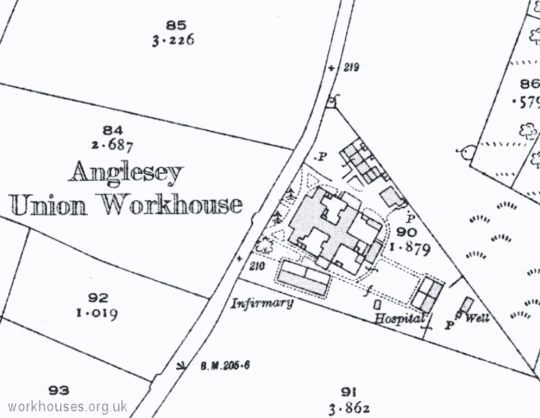
Anglesey site, 1920.
The workhouse had a cruciform main building with asubstantial entrance block at the west, most of the building being two storeys in height.
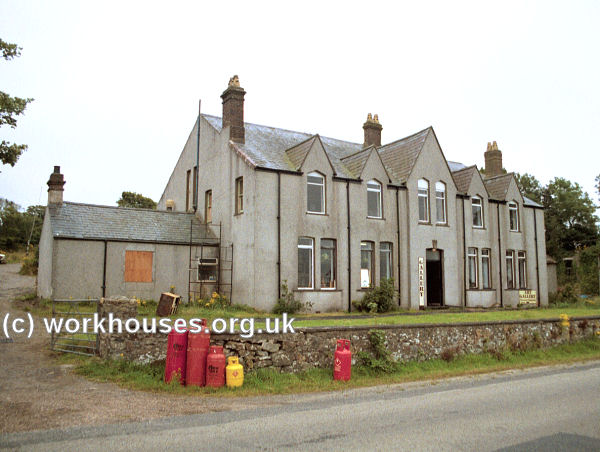
Anglesey workhouse entrance block from the north-west, 2000.
© Peter Higginbotham.
On the ground floor of the entrance block, at the left of the entrance door, was the guardians' boardroom with the school room to its rear. At the right of the entrance were a clerk's office and a parlour with a waiting room and the master's room to the rear. The single storey wings to the left and right were boys and girls' dayrooms.
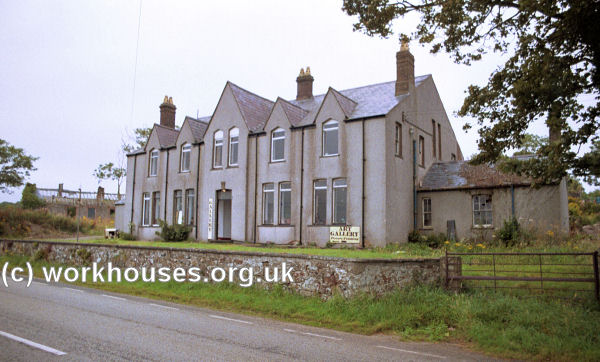
Anglesey workhouse entrance block from the south-west, 2000.
© Peter Higginbotham.
A single-storey dining hall, flanked by the boys' and girls' yards, linked the entrance block to the now demolished main accommodation section. On its ground floor was the kitchen, with pantries and scullery behind, separating the women's and men's yards. On the male side, at the south of the kitchen, were the able-bodied and infirm men's dayrooms. A similar pattern existed on the women's side, with the addition of access to the laundry block at the rear. There were dormitories on the upper floor.
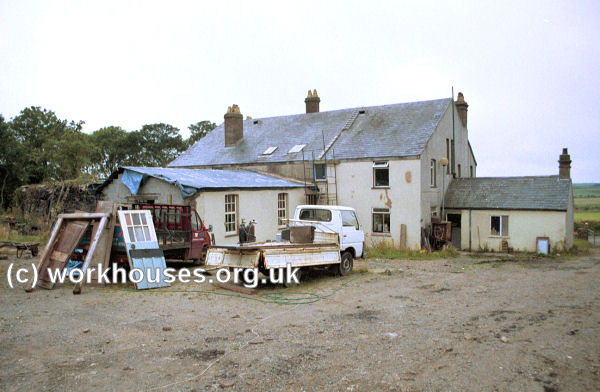
Anglesey workhouse entrance block from the east, 2000.
© Peter Higginbotham.
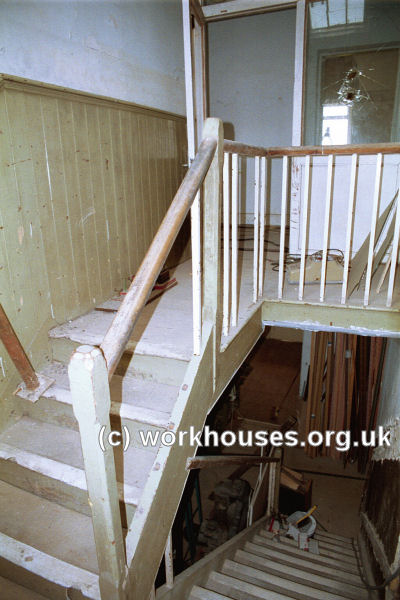
Anglesey workhouse internal staircase, 2000.
© Peter Higginbotham.
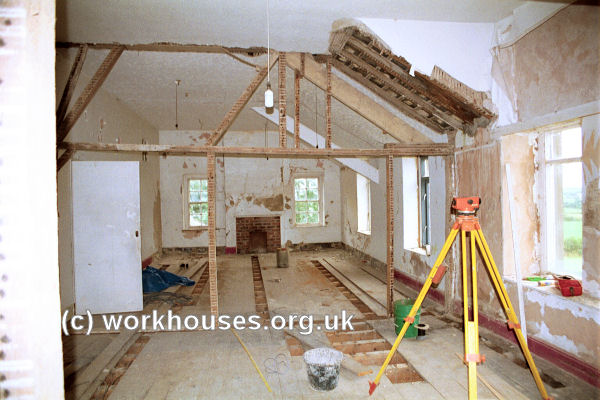
Anglesey workhouse upper floor interior, 2000.
© Peter Higginbotham.
Several single-storey outbuildings stood around the workhouse including a vagrants' ward with stone-breaking cells at the north, an infirmary at the south, and an isolation block at the east.
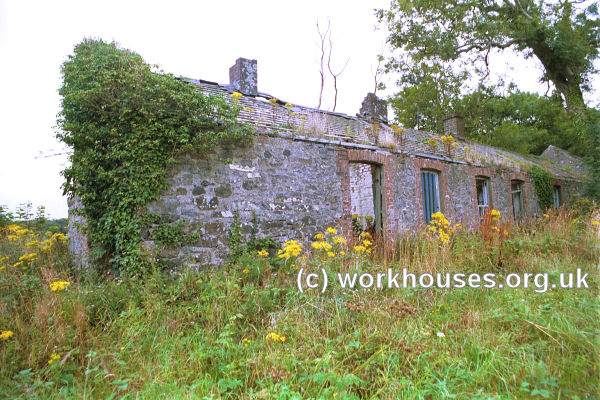
Anglesey workhouse tramps' block from the west, 2000.
© Peter Higginbotham.
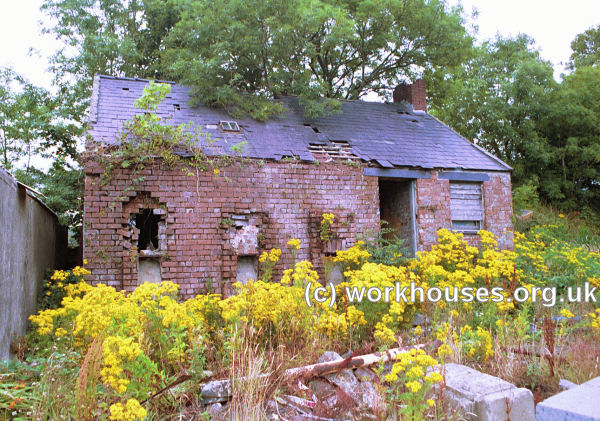
Anglesey workhouse tramps' stone-breaking block, 2000.
© Peter Higginbotham.
In 1869, Meshach Thomas, formerly schoolmaster at the Bangor workhouse, and his wife, Grace Thomas, were appointed as the first master and matron at the new Llanerchymedd workhouse. They were in post until around 1900. The picture of the Thomases in front of the workhouse was kindly contributed by their descendant Hugo Vanneck.
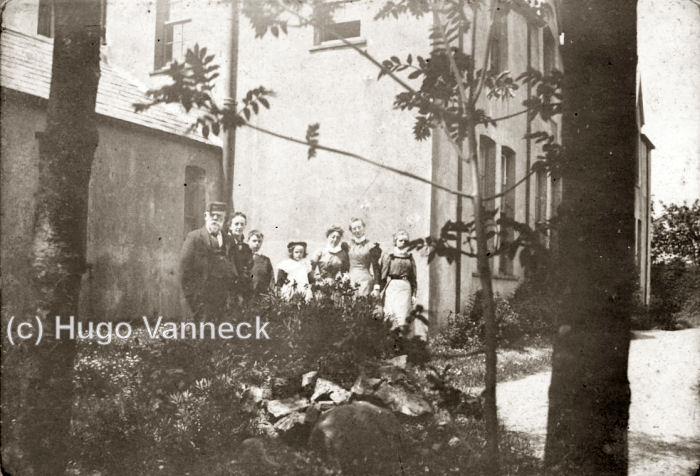
Meshach Thomas and family at Anglesey workhouse, 1880s.
© Hugo Vanneck.
The workhouse had closed by 1921. The premises, renamed Bryn Hafod, were later used as council offices. The buildings were left empty in the 1980s and became derelict. In around 2000, the buildings were renovated to form residential and gallery accommodation.
Staff
- 1881 Census
- 1869-1900: Master - Meshach Thomas; Matron - Grace Pryse Thomas.
Inmates
Records
Note: many repositories impose a closure period of up to 100 years for records identifying individuals. Before travelling a long distance, always check that the records you want to consult will be available.
- Anglesey Archives, Industrial Estate Road, Bryn Cefni Industrial Estate, Llangefni, Anglesey LL77 7JA. Holdings include Guardians' minute books (1837-1930); Admissions/discharges (1887-1918); Out-relief records (1848-1919); etc.
Bibliography
- Higginbotham, Peter The Workhouse Encyclopedia (2014, The History Press)
- NEW! Workhouses of Wales and the Welsh Borders. The story of the workhouse across the whole of Wales and the border counties of Cheshire, Gloucestershire, Herefordshire and Shropshire. More...
Links
- None.
Unless otherwise indicated, this page () is copyright Peter Higginbotham. Contents may not be reproduced without permission.


